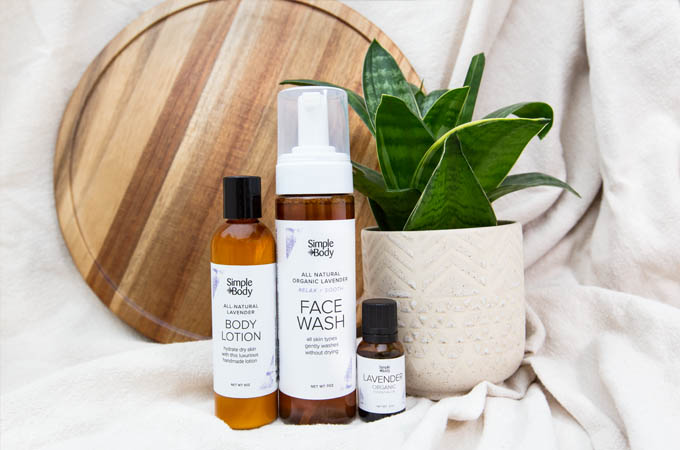
Lavender and your Skin
You may notice that many Simple Body products contain Lavender Lavandula angustifolia essential oil, and it’s not just because it smells amazing! There are so many benefits to incorporating this beautiful-smelling oil into your life. Let’s discuss a few of these reasons, along with what to know before choosing products made with it.
Lavender Essential oil
Lavender L. angustifolia originates in the mountains of the Mediterranean and belongs to the Lamiaceae family. Other commonly used plants in this family include Clary Sage Salvia sclarea, Peppermint Mentha xpiperita, and Rosemary Rosmarinus officinalis. Manufacturers use several varieties of Lavender to distill essential oil within the genus Lavandula. For this reason, the Latin name (italicized words) should always be included on the label when purchasing essential oil or products with Lavender as an ingredient. Knowing this is important because the benefits and precautions will vary depending on the variety of Lavender you choose. For example, Lavandin Lavandula xintermedia (Spike Lavender) has a higher percentage of Camphor than Lavender L. angustifolia. Camphor is actually stimulating, not sedating, so using this oil before bed will most likely not result in a good night’s sleep. So, always purchase essential oils from a trusted manufacturer with proper labeling and storage methods.
Physical Benefits
There are so many reasons why Lavender L. angustifolia and skincare go hand in hand. Even its’ name comes from the Latin word lavare, meaning “to wash.” Some properties that make it exceptional in your skincare routine include its antimicrobial, antiseptic, and astringent properties. What does that mean? An antimicrobial can destroy or suppress microorganisms like those found in acne. The antiseptic action helps prevent decay and aids in cell regeneration, and an astringent contracts tissues to help firm and decrease moisture loss. You can see why Lavender L. angustifolia essential oil is a key ingredient in skincare products, especially for people with combination skin.
Individuals with Combination skin often experience too much oil in the T zone (forehead, nose, and chin) and dry skin everywhere else. Combination skin requires a unique line-up of skincare products designed to moisturize yet address the oiliness of the T zone. Simple Body has the answer! Lavender Foaming Face Wash, Clean Sweep Toner, Daily Face Cream, and Beauty Balm for your morning skincare routine, and a French Green clay mask, Lavender Bamboo Face Polish, and pumpkin enzyme mask 1-2 times a week to exfoliate dead skin cells that can clog your pores.
Other Benefits
Lavender L. angustifolia essential oil also has antidepressant, anti-inflammatory, analgesic (pain-reliever), antispasmodic (relax muscles), and nervine (tones and heals nerves) properties. These properties are why you will find this essential oil in products designed to reduce anxiety. Several peer-reviewed research studies have backed its versatility. Recently, researchers Akgül et al. (2021) found that children with second-degree burns who inhaled Lavender L. angustifolia essential oil for 15 minutes before changing their wound dressing had decreased pain levels, respiratory rate, heart rate, and blood pressure. And unlike antianxiety medications, muscle relaxants, and sleep aids, it doesn’t have adverse side effects like dependence or withdrawal symptoms.
To sum up, Lavender L. angustifolia has many benefits and medicinal uses for your skin and beyond. It can reduce scarring, stretch marks, sun damage, skin growths, and varicose veins. You can also use it on insect bites and burns to relieve pain. Used in a regular skin routine, it can effectively reduce acne, tone skin, and help regenerate new skin cells. It can also reduce anxiety, help you sleep, and relax muscles. So, as you can see, Lavender is more than just a pretty-smelling flower. It’s a botanical powerhouse!
References
Ardahan Akgül, E., Karakul, A., Altın, A., Doğan, P., Hoşgör, M., & Oral, A. (2021). Effectiveness of lavender inhalation aromatherapy on pain level and vital signs in children with burns: a randomized controlled trial. Complementary therapies in medicine, 60, 102758. https://doi.org/10.1016/j.ctim.2021.102758
